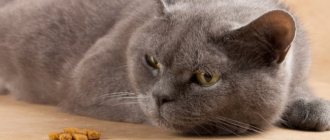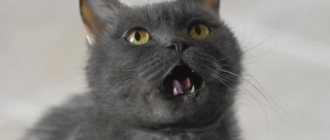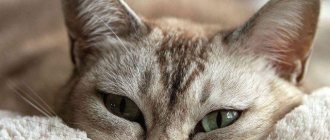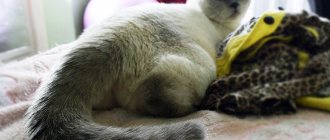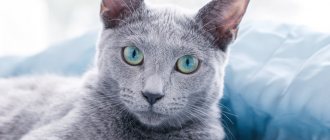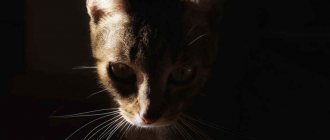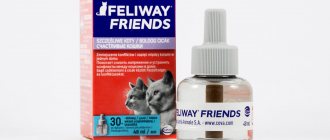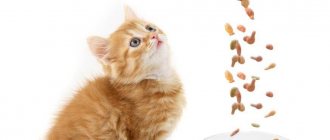10581Administration
4
Usually, a furry baby that appears in the house develops quickly, which certainly pleases its owners. But quite often it happens that it does not reach the required size at a certain age. An attentive owner will immediately notice this and think about why the kitten is not growing and how to fix it.
In this situation, only a veterinarian can give a complete, and most importantly, correct answer after an individual examination of the animal. After all, the topic of poor growth of pets is relevant and requires certain knowledge to correct the situation.
© shutterstock
Why doesn't the cat grow?
Usually, a furry baby that appears in the house develops quickly, which certainly pleases its owners.
But quite often it happens that it does not reach the required size at a certain age. An attentive owner will immediately notice this and think about why the kitten is not growing and how to fix it. In this situation, only a veterinarian can give a complete, and most importantly, correct answer after an individual examination of the animal. After all, the topic of poor growth of pets is relevant and requires certain knowledge to correct the situation.
The main reasons for stopping or stunting a kitten's growth
If a kitten has problems, their consequences will become noticeable in the first month of life.
The main reasons why a kitten does not grow are::
- Poor, insufficient nutrition. In the first month of life, a kitten may suffer from a lack of milk from its mother cat. In older age, nutrition is most often simply inadequate; it lacks either nutrients or calories.
- Unbalanced diet and regimen. When a kitten does not eat well or the normal feeding regime is disrupted, then it gains little weight. In particularly advanced cases, it does not grow at all.
- Heredity or genetic abnormalities. When getting a purebred kitten, you need to know exactly what diseases it can get from its parents. This will significantly save time when identifying the reasons for poor development and will allow you to quickly decide what to do in the current situation. In addition, it is worth considering what size the pet’s parents were at the same age. It is quite possible that if the kitten is in good health, it does not grow and remains quite small, because its parents were not large either.
- Viral and infectious diseases. Often, being underweight is a consequence of past illnesses. Infections, affecting the kitten’s fragile body, lead to disruption of the gastrointestinal tract, which impairs the absorption of nutrients. Accordingly, their level in the blood decreases sharply, the organs do not receive enough of the materials they need, and the kitten grows slowly or stops gaining weight altogether.
- Infection with worms. If a kitten gets worms, this inevitably leads to sad consequences. Whatever the age of the pet, helminthic infestations will always be dangerous to its health and even life. Because of them, the kitten not only grows poorly, but can also die.
Factors influencing growth
Gender also affects the size of the animal, for example, the muzzles of females are almost always narrower and more elongated than those of cats. If the cat's face stops growing, it means that the skeleton is formed, the head and shoulder width will remain at this level and will not grow any further. As a rule, this occurs by 2 years.
Internal factors
The age at which cats grow is not the only factor in an animal’s growth. There are external and internal factors influencing the development of an animal. The main internal factor is breed. Representatives of large breeds grow longer than miniature ones.
Table: average sizes for different breeds
| Breed | Weight Limit |
| Maine Coon | 18 kg |
| Persian | 6.8 kg |
| Kurilian Bobtail | 5–6 kg |
| British Shorthair | 8 kg |
| American Curl | 4–5 kg |
| Russian blue | 7 kg |
| Egyptian Mau | 7 kg |
| Sphinx | 6 kg |
| Scottish lop-eared | 6 kg |
| Siamese | 5 kg |
| Snow shu | 5–6 kg |
| Munchkin | 3–4 kg |
Munchkin cats have short legs, which makes them appear short.
Heredity can also affect the size of the animal. Kittens, like all children, look like their parents. Slender and miniature cats rarely give birth to “chubby” kittens. Such cubs mature slowly. Conversely, the offspring of large females grow rapidly, regularly gaining weight.
In fact, she looks funny - her head is small, her pug-like features are small, and her body is just very big. Somehow disproportionate from the outside. But we saw her parents - her dad is the same - a big belly and a small head.
queenan, owner of a “fat” kitten
https://eva.ru/static/forums/30/2005_9/423431.html
Another internal factor is endocrine imbalance, which affects how old cats grow. Most often it occurs after the use of hormonal drugs (for example, there was treatment with hormones). In addition, hormonal imbalance can occur due to improper functioning of the endocrine system (disturbances in the functioning of the adrenal glands, reproductive system, thyroid gland, etc.). Sometimes an active pet of a medium-sized breed grows very large, despite the fact that the parents were miniature.
In Queensland (Australia) there lived a cat named Himmi. The cat's owner was Thomas Wise. Himmi lived a little over 10 years and reached a weight of 21 kg. The cat's abdominal circumference was 84 cm. Himmi was about 100 cm long (from his nose to the tip of his tail). Himmi was recognized as the fattest cat in the world. It was difficult for the cat to walk due to his height and size, and Thomas had to carry him in a special wheelbarrow. Himmi died in 1968.
Some cats grow so big that it is difficult for humans to hold them in their hands.
External factors
In addition to internal factors influencing growth, there are also external ones. The most significant external factor is the animal’s nutrition. If a cat is fed high-quality, balanced food, then it grows up to be active, athletic and moderately well-fed. With improper nutrition, a cat's growth can slow down or speed up. Nutrition affects not only the functioning of the gastrointestinal tract, but also the growth of the musculoskeletal system.
I feed my cat homemade food, but I also try to make sure she gets all the vitamins and nutrients she needs. Cats love fish very much (it is healthy due to its phosphorus content), so for them I buy fish separately (so that it is not too fatty). It is also important that your pet receives calcium. A lot of calcium is found in dairy and fermented milk products.
In addition, the following living conditions contribute to the proper growth and development of the animal:
- First, the space for the animal must be appropriate for the size of the animal. After all, a kitten will not grow into a big cat if it lives in a shoebox.
Living conditions are important for the growth of a cat: you need to choose a place of suitable size for him
- Secondly, you need to monitor sanitary and hygienic conditions. Your pet can get sick if it eats from unwashed dishes, goes into a dirty litter box, etc. And any disease will certainly affect the development of the animal’s body. Unsuitable living conditions can lead to helminthiasis or other types of parasitic diseases. If the coat is not properly cared for, the animal may be attacked by fleas. Such a cat will suffer, constantly itch and may get sick. An animal tormented by worms and fleas cannot develop normally.
Sterilization can also lead to changes. Everyone knows that sterilized cats gain weight and become lazy. Some owners even like it. But, if the fluffy gains weight, then he suffers due to hormonal changes. Indeed, in addition to weight gain, the cat can continue to increase in size (for example, bones). In addition, growth impairment can occur due to stress. So, if a cat’s body begins to produce hormones that it is not used to, this can lead to changes in development.
Video: how to properly feed a neutered cat
What to do if the kitten does not grow.
As soon as it becomes noticeable that his kitten is no longer growing, you should urgently contact a veterinarian, because each case is unique and requires an individual examination. Most often, the diagnosis will be one or more of the above reasons. They are eliminated like this :
- The kitten's diet and diet are being reviewed. If tests confirm a lack of vitamins, macro and microelements, then a course of vitamin complexes is prescribed, after taking which the pet quickly grows and develops again.
- Hereditary and genetic diseases, in most families, cannot be treated. But you can always slow down their progression with medication, blunt the development of consequences and improve the kitten’s condition.
- Infectious diseases are treated with medications. Afterwards, you need to adhere to a certain diet for some time, after which the kitten grows normally again and gains weight.
- Worms are also treated with medications. But it’s better not to wait for them to appear, but to do preventive measures two or three times a year.
Thus, to find out exactly why a kitten is not growing, it is best to consult with a specialist who will identify the cause and prescribe the correct treatment for your pet.
Diagnosis of acromegaly
Diagnosis of the disease is carried out by an endocrinologist. To do this, you need to visit a medical center and take laboratory tests:
- blood (determine the amount of phosphorus, hormones);
- urine (for calcium content).
The next steps will be:
- x-ray - will show changes in the skeletal system;
- computed tomography (CT), magnetic resonance imaging (MRI) - will determine the condition of the pituitary gland, the absence or presence of tumor formations;
- examination by an ophthalmologist;
- consultation with a neurologist.
Having understood the causes of the disease, the doctor will prescribe adequate treatment. Medicine knows cases when patients recovered. But external changes will remain forever.
What to do if the cat is not growing?
What should an owner do if he notices signs of slow growth or cessation in his pet? People who are interested in cats and their lives have probably heard more than once that kittens sometimes do not want to grow up. Indeed, cases where kittens grow very slowly or suddenly stop growing are not so rare.
For the development of a kitten and its growth, first of all, proper and balanced nutrition is important.
It must contain a sufficient amount of nutrients, as well as all the vitamins and minerals necessary for the growth and development of a young body.
It's no secret that animals - just like children - grow quite quickly.
How do I know if my kitten is growing?
The growing period is an important part of a cat's development. You can buy a baby scale and weigh her every day to track her growth on a graph. The curve connecting each point should be steep at first and then gradually level off as she reaches six months of age. As a guide, most kittens gain 100 grams of body weight per week until they are 6 months old.
Your veterinarian can also provide you with a kitten growth chart, which works like a baby growth chart. You can chart your kitten's growth and make sure he is within two percentiles of where he started. In other words, a small kitten should grow proportionately at the same rate as a large kitten, but it will eventually turn into a small cat. Likewise, a large kitten will follow the same growth curve and will eventually become a larger cat than an adult.
The average weight of a kitten usually follows the rule: about 450 grams for each month until 10 months of age. Keep in mind that males are usually larger than females. Other signs that your cat is growing properly are that she is interested in food, active during the day, and playful with other family members.
What to do if the kitten is not growing? Why the kitten is not growing: indicators of kitten development
Domestic cats usually boast a stable appetite and approximately the same weight within ten kilograms. Why is the kitten not growing, and is it possible that the problem arose due to genetic problems in the baby’s parents?
How much should a cat or kitten weigh?
Although cats don't vary in weight as much as dogs, they still have a wide range of "normal" weights. While the "average" cat weighs around 5kg at adult weight, cats can range from 2kg to 10kg and still be fit and healthy. This option mainly depends on the breed. However, among the "mixed breed" or "domestic shorthair" cats, they can still easily range from being thin but holding 2kg to being big-boned 7kg!
In other words, every cat is unique! So how can you tell if your kitten is growing normally or if your cat is just such a small problem?
Causes of delayed development
Why a cat is not growing is a serious question that must be resolved based on the well-being of the pet, its age and genetic indicators of the species. Growth problems in a baby may arise due to similar abnormalities in the parents. If the baby’s father or mother is not of decent size, then he could inherit this feature at the genetic level. These kids grow much slower than their peers, but at the same time they play actively and eat a lot.
Another problem that can explain what is happening is the presence of worms in the kitten. These parasites negatively affect the animal's body, preventing it from developing normally. As a result, the baby grows extremely slowly, and his immune system is always under threat.
Why doesn't the kitten that was the smallest in the litter grow? Here we can talk about insufficient nutrition from the first days of life. Those babies who are the weakest in the litter usually receive little milk. As a result, their stomach is narrowed, and in the future, even with a normal diet, the pet will consume very little food. Poor appetite will lead to the fact that the kitten will develop very slowly, and various diseases will overcome it on a regular basis.
It is difficult to make a diagnosis on your own, but you should not ignore the problem. The veterinarian will be able to assess the situation and find out why the kitten is growing so slowly.
Sometimes growth problems occur in a kitten due to problems with the digestive system. In such a situation, the cat eats a lot and consistently, but the food is poorly digested, and slow digestion negatively affects natural growth.
Features of alopecia areata in men
In most cases, men do not pay attention to increased hair loss due to short haircuts. Therefore, for a long time they arrive in confidence that everything is normal with their hairstyle, missing the first signs of alopecia areata. Only when it is impossible not to notice the disease - bald spots appear on the head - do they begin to sound the alarm.
Doctors have not yet figured out the exact reasons for the occurrence of the nesting form. Different chronic diseases and pathological conditions lead to hair loss in different patients. But the result is the same - hairless areas of round or oval shape appear on the head. Along the edges of the bald spots, the hair is shortened, with broken ends. The skin in such places is reddish and appears inflamed.
The basis of the disease is damage to the hair follicles. Sometimes pathology is also observed on the nails. In addition to the scalp, other areas of the body are also affected. Eyebrows and eyelashes may noticeably thin, and hair on the chest or back may disappear.
Alopecia areata develops rapidly. Sometimes a week is enough for a completely hairless area to appear. It proceeds unevenly - stages of remission may alternate with relapse periods.
Doctors note that alopecia areata is the most complex form of baldness. It is difficult to treat as it is associated with chronic diseases. Often the only treatment option is hair transplantation. But this path is not a guarantee that new outbreaks will not appear in the future.
Men of different age groups are susceptible to pathology. There are 4 types of nested forms of baldness:
- in men from 20 to 40 years old.
The most common type. With treatment, hair is restored within 6 months. Complete baldness rarely occurs; - in children
. Occurs in 10% of patients. The disease progresses for a long time and can take up to 10 years. Hair return is slow and difficult, taking more than a year. The result of the pathology can be complete baldness; - age up to 20 years
. The rarest type. It is developing rapidly. In half of the cases it threatens complete hair loss; - in men over 40 years of age
. Develops slowly. Complete baldness occurs extremely rarely.
A connection has been noted between the appearance of the nesting form and hair color - brunettes suffer from it more often than blondes.
Ways to combat stunted growth
Why a kitten grows poorly is a natural question, and methods of dealing with the problem should be tailored to the cause of its occurrence. For example, a kitten may suddenly stop growing due to the development of infectious diseases. In such cases, babies lose their appetite, their activity decreases, and, on the contrary, their temperature increases. Infectious diseases should be treated only with special medications and only after careful consultation with a veterinarian.
If the baby has a decreased appetite, then veterinarians advise introducing special vitamins into the diet or using little tricks. 10-15 minutes before food is served to the cat, you need to lubricate its nose with milk. By licking the milk, the pet, without realizing it, will awaken its appetite, and the entire portion of the food provided will be eaten.
An unbalanced diet is a common problem that can cause a kitten to grow very slowly. It is necessary to ensure that the animal’s food contains meat, milk, and plant products. Protein is especially important for babies, as it affects growth and strengthens bones. That is why dairy products become the basis of the diet for kittens under six months of age. It is also not recommended to suddenly change the animal’s diet, otherwise its appetite may decrease, which will immediately affect the pet’s natural growth.
Sometimes developmental and growth problems occur due to the development of chronic diseases in a pet. In such cases, you have to regularly undergo medical examinations and purchase preventive medications for the cat.
Slow growth of a kitten is always an alarming symptom and should never be ignored. The faster the owner finds out the cause of such a problem, the greater the chance that it will be possible to get rid of it in time without consequences for the health of the animal.
Features of cat growth
The growth of cats is not only an increase in body length and weight gain. Growth is the complete formation of all organs and systems in the body of an animal. However, when choosing a pet, cat lovers attach importance to external indicators: length and height of the body, weight, etc. The size of the cat depends on the breed, health status and living conditions. Often a pet stops growing due to belonging to a certain breed.
Medium-sized cats grow until they are approximately 12–14 months old. If the animal is a large breed (for example, Maine Coon), then it takes more than 2 years to grow.
The kitten begins to grow rapidly at the age of six months.
Some kittens don't grow up to be big cats because of their breed.
Stages of growth
There are four periods of cat growth (from birth to adulthood):
- The first period is neonatal. These are the first four days of a kitten's life. At this time, the weight of the animal may change (increase or decrease). The nature of the changes depends on how the birth proceeded.
- Next comes the suckling period. At this stage, the kitten is steadily gaining weight. The suckling period lasts about a month.
- The transition period lasts from four to seven weeks. At this time, the kitten's growth slows down. The animal switches to a different type of nutrition: kitten milk is replaced with solid food. After a complete transition to “teenage” nutrition, growth accelerates.
During the transition period, the kitten begins to eat solid food instead of mother's milk.
- After 7–8 weeks, the post-lactation period begins. It lasts until the final formation of the body. The kitten grows independently and ceases to depend on feeding from the mother.
Normal growth is 10–15 g per day. A healthy kitten spends the first weeks of life most of its time sleeping, waking up only to eat. A kitten experiencing discomfort shows signs of anxiety, squeaks, looks lethargic, does not suck mother's milk well, and may have upset stools. If these signs occur, you should consult a veterinarian. During the suckling period, kittens receive ready-made antibodies from their mother's milk, so infectious diseases are less common at this age. However, a small kitten generally has very low body resources, and if a failure occurs somewhere, this leads to a rapid deterioration in the general condition, even to death.
Izhena, zoo guru
https://forum.zooshans.by/viewtopic.php?f=27&t=59
Malnutrition
One of the most common reasons why a kitten is not growing or gaining weight is a lack of food. The smallest babies may simply not have enough mother's milk. In this case, you will have to feed the kittens manually. At an older age, the kitten does not grow due to the too meager rations that it receives. Normally, a one and a half month old baby is fed up to 5 times a day. At this age, his stomach is small and cannot accommodate large volumes, so he is fed often, in small portions.
Unbalanced diet
An unbalanced diet is the second most common reason that a kitten does not grow or gain weight. Delay in development occurs as a result of feeding food that does not contain the substances necessary for its growth - proteins, fats, vitamins and microelements. If the animal is not fed properly, it may show signs of rickets and anemia. The kitten is not growing, the weight gain is very insignificant, it is lethargic and sits near the bowl for a long time, waiting for more nutritious food. If these signs appear, you should review your pet’s diet and adjust it according to its age.
Worm infestation
Worms can also lead to weight loss. In this case, the kitten does not grow or gain weight due to the fact that the parasites suck out all the nutrients from the food, leaving nothing for its owner. A characteristic sign of helminthic infestation is the animal’s good appetite with low body weight gain. The kitten is not growing or gaining weight, although it is eating well and its tummy feels firm to the touch. Constipation or diarrhea may occur. When examining stool, helminth eggs are found. How to deal with this disease is here.
Viral infection
Infectious diseases, colds or intestinal diseases are another common reason that a kitten is not growing or gaining weight. The mucous membrane through which nutrients are absorbed is affected. Even if the baby maintains a good appetite, the supply of proteins, fats and carbohydrates necessary for his growth and development slows down greatly or stops altogether. The kitten does not grow and does not gain weight, since its body simply has nothing to build its cells and tissues from.
Sometimes a kitten does not grow or gain weight even some time after the illness due to deep organic damage to the intestines. In this case, the recovery period is delayed and the owners feel that the kitten is not growing. In this case, there is no need to panic. A few days of a gentle diet, a course of vitamin therapy and the weight quickly returns to normal.
Genetic abnormality
Very rarely, the reason that a kitten does not grow and does not gain weight can be a genetic anomaly, which results in dwarfism of the animal. As a rule, these are babies abandoned in early childhood by their mother cat, who have visible defects in skeletal development. Such a kitten does not grow due to underdevelopment caused by the mutation.
Unfortunately, such animals have very little chance of survival, since internal organs and the musculoskeletal system are also affected. Such a kitten does not grow, does not gain weight, and often gets sick. Its lifespan is usually no more than a few months. There is no cure. Vitamin therapy, immunostimulants and a special diet can be used as supportive measures.
In conclusion, it only remains to add that, regardless of the cause of growth retardation, you should not self-medicate, especially if there is an infectious disease or the kitten is not growing due to pathology of the internal organs. At the first signs of illness, you should contact a veterinarian who will conduct a full examination and prescribe treatment.
Did you like the article and was it useful? Please share with your friends.
